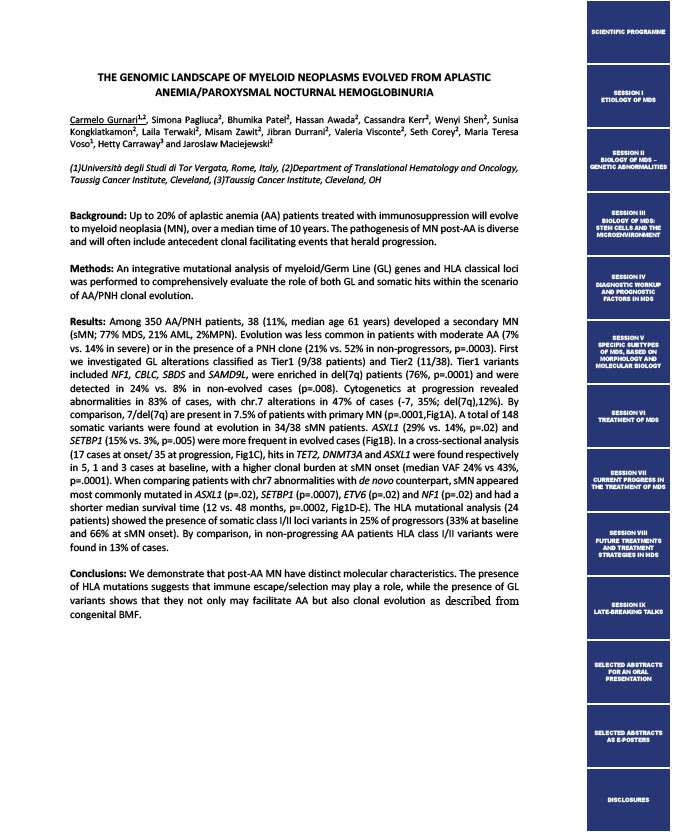
THE GENOMIC LANDSCAPE OF MYELOID NEOPLASMS EVOLVED FROM APLASTIC
ANEMIA/PAROXYSMAL NOCTURNAL HEMOGLOBINURIA
Carmelo Gurnari1,2, Simona Pagliuca2, Bhumika Patel2, Hassan Awada2, Cassandra Kerr2, Wenyi Shen2, Sunisa
Kongkiatkamon2, Laila Terwaki2, Misam Zawit2, Jibran Durrani2, Valeria Visconte2, Seth Corey2, Maria Teresa
Voso1, Hetty Carraway3 and Jaroslaw Maciejewski2
(1)Università degli Studi di Tor Vergata, Rome, Italy, (2)Department of Translational Hematology and Oncology,
Taussig Cancer Institute, Cleveland, (3)Taussig Cancer Institute, Cleveland, OH
Background: Up to 20% of aplastic anemia (AA) patients treated with immunosuppression will evolve
to myeloid neoplasia (MN), over a median time of 10 years. The pathogenesis of MN post-AA is diverse
and will often include antecedent clonal facilitating events that herald progression.
Methods: An integrative mutational analysis of myeloid/Germ Line (GL) genes and HLA classical loci
was performed to comprehensively evaluate the role of both GL and somatic hits within the scenario
of AA/PNH clonal evolution.
Results: Among 350 AA/PNH patients, 38 (11%, median age 61 years) developed a secondary MN
(sMN; 77% MDS, 21% AML, 2%MPN). Evolution was less common in patients with moderate AA (7%
vs. 14% in severe) or in the presence of a PNH clone (21% vs. 52% in non-progressors, p=.0003). First
we investigated GL alterations classified as Tier1 (9/38 patients) and Tier2 (11/38). Tier1 variants
included NF1, CBLC, SBDS and SAMD9L, were enriched in del(7q) patients (76%, p=.0001) and were
detected in 24% vs. 8% in non-evolved cases (p=.008). Cytogenetics at progression revealed
abnormalities in 83% of cases, with chr.7 alterations in 47% of cases (-7, 35%; del(7q),12%). By
comparison, 7/del(7q) are present in 7.5% of patients with primary MN (p=.0001,Fig1A). A total of 148
somatic variants were found at evolution in 34/38 sMN patients. ASXL1 (29% vs. 14%, p=.02) and
SETBP1 (15% vs. 3%, p=.005) were more frequent in evolved cases (Fig1B). In a cross-sectional analysis
(17 cases at onset/ 35 at progression, Fig1C), hits in TET2, DNMT3A and ASXL1 were found respectively
in 5, 1 and 3 cases at baseline, with a higher clonal burden at sMN onset (median VAF 24% vs 43%,
p=.0001). When comparing patients with chr7 abnormalities with de novo counterpart, sMN appeared
most commonly mutated in ASXL1 (p=.02), SETBP1 (p=.0007), ETV6 (p=.02) and NF1 (p=.02) and had a
shorter median survival time (12 vs. 48 months, p=.0002, Fig1D-E). The HLA mutational analysis (24
patients) showed the presence of somatic class I/II loci variants in 25% of progressors (33% at baseline
and 66% at sMN onset). By comparison, in non-progressing AA patients HLA class I/II variants were
found in 13% of cases.
Conclusions: We demonstrate that post-AA MN have distinct molecular characteristics. The presence
of HLA mutations suggests that immune escape/selection may play a role, while the presence of GL
variants shows that they not only may facilitate AA but also clonal evolution as described from
congenital BMF.
SCIENTIFIC PROGRAMME
SESSION I
ETIOLOGY OF MDS
SESSION II
BIOLOGY OF MDS –
GENETIC ABNORMALITIES
SESSION III
BIOLOGY OF MDS:
STEM CELLS AND THE
MICROENVIRONMENT
SESSION IV
DIAGNOSTIC WORKUP
AND PROGNOSTIC
FACTORS IN MDS
SESSION V
SPECIFIC SUBTYPES
OF MDS, BASED ON
MORPHOLOGY AND
MOLECULAR BIOLOGY
SESSION VI
TREATMENT OF MDS
SESSION VII
CURRENT PROGRESS IN
THE TREATMENT OF MDS
SESSION VIII
FUTURE TREATMENTS
AND TREATMENT
STRATEGIES IN MDS
SESSION IX
LATE-BREAKING TALKS
SELECTED ABSTRACTS
FOR AN ORAL
PRESENTATION
SELECTED ABSTRACTS
AS E-POSTERS
DISCLOSURES